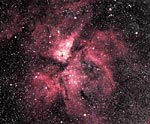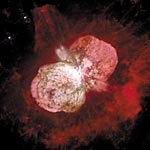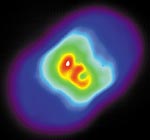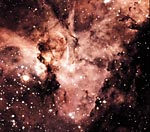|
|  |  | | Eta Carinae itself lies hidden
among the rich gas and dust just north (above) of the bend in the dark wedge at
center.
Luke Dodd | |
Like a king, this gigantic
star imperiously ordains the life and death of all its neighbors. Some stars it
feeds, providing the complex molecular material used by newborn stars to coalesce
and form. Others it annihilates, exterminating any life that might dwell within
nearby stellar systems.
The star shines so brightly that it would appear as bright as the
sun does in our sky from 185 billion miles away — some 50 times the distance to
Pluto. With about 120 times the mass of the sun, it comes close to the
theoretical limit of how big a star can be. And although it lies 7,500
light-years away, the star glittered more brilliantly than any other star in the
Galaxy between approximately 1835 and 1855. During this 20-year Great Eruption,
it ejected two to three suns' worth of material.
The star is Eta Carinae,
considered by many astronomers to be the brightest object in the Milky Way Galaxy
and among its heaviest. It is also one of the strangest and rarest of stellar
bodies — a gargantuan variable star that fluctuates in an irregular and
completely unpredictable manner.
Today Eta Carinae remains luminous and unstable,
surrounded by one of the most beautiful and distinct nebulae in the heavens.
Moreover, astronomers were astonished recently when — without any warning — it
suddenly began to brighten again at all wavelengths. In the past year its
brightness has more than doubled, leaping upward so that the star and its
surrounding nebula now glow around 5th magnitude, the brightest in more than a
century.
One
hundred and fifty years ago, the English amateur astronomer John Herschel asked:
"What origin can we ascribe to these sudden flashes and relapses?" His question
remains unanswered, no doubt in part because this regal star continues to be
cloaked by dusty clouds. In fact, astronomers are not even sure if Eta Carinae is
a single star. To paraphrase Winston Churchill, Eta Carinae remains "a riddle
wrapped in a mystery inside an enigma."
Yet, Eta Carinae's place in
stellar evolution is crucial. Its mysterious behavior challenges every theory
that tries to explain the life and death of stars — including our own sun. Its
future activity might even tell us why, where, and when other stars go
boom.
The
Great Eruption
Kris Davidson of the University of Minnesota has said that
Eta Carinae "is to the Southern Hemisphere what the Crab Nebula is to the north."
Until the third decade of the 19th century, however, Eta Carinae was considered
an unusual but undistinguished variable star, sometimes glowing at 4th magnitude,
sometimes at 2nd. Then in the 1830s, John Herschel noticed that the star's light
had risen steeply and, by December 1837, had reached 1st magnitude. Puzzled by
this strange jump in brightness, Herschel researched the history of the star and
discovered that it had also reached 1st magnitude in 1827 and again in 1832.
After fading in 1838, the star blazed forth in 1843, zooming to a magnitude of –1
and becoming, for a short period, the second brightest star in the sky, eclipsed
only by Sirius.
For the next twenty years, Eta Carinae remained among the sky's
most brilliant stars, fading in fits and jerks until it finally dropped below
naked-eye visibility in 1868, stabilizing at about 7th magnitude. In 1889 the
star brightened for a short while, barely reaching 6th magnitude, then settled
back down to a relatively quiet, stable glow around 8th magnitude for the next
few decades.
In recent years, Eta had been growing slowly brighter, rising
almost a full magnitude from 1950 to 1992. During this period scientists
continued to puzzle over the star's nature. Though ground-based photographs
showed that Eta was surrounded by a rapidly expanding cloud that could be traced
back to the Great Eruption of 1843, the resolution of the images wasn't high
enough to ascertain the exact structure or learn how the cloud interacted with
the star. Because its shape resembled that of a human, Enrique Gaviola of the
Cordoba Observatory in Argentina dubbed this nebula the Homunculus, which means
"little man."
Then in 1994, the Hubble Space Telescope received a set of
corrective lenses, and Eta Carinae became one of the first targets for the newly
repaired telescope. The stunning image unveiled a star erupting. Suddenly, after
centuries of unclear vision, scientists and ordinary citizens could look at the
nebulosity surrounding the star and see its shape and detailed
structure.
 |
 |
| | Hubble's view of the Homunculus Nebula reveals materials thrown
off in the 1843 Great Eruption.
NASA/STScI |
The Homunculus
The most obvious features in the Hubble images are the two large and grayish
bipolar lobes, shaped somewhat like an hourglass. With a total mass somewhere
around three times that of the sun, their glow comes mainly from starlight
radiated by Eta Carinae that reflects off the ubiquitous dust in the lobes.
Ejected from the star during the 1843 eruption, each lobe is expanding outward at
the rate of about 1.5 million miles per hour. At this great speed — fast enough
for a spaceship to travel to the moon and back three times in an hour — the lobes
have expanded in 150 years to span about four trillion miles, or some 0.7
light-year.
In all likelihood, the lobes are mostly hollow, though
astronomers have detected evidence of some dust within them. No one knows whether
the lobes are shaped like spheres or cones. Either way, they apparently formed
when matter was ejected from the star's polar regions. Perhaps this happened
because Eta Carinae spins rapidly, possesses a powerful magnetic field, belongs
to a binary star system, or some combination of these factors. Regardless, the
ejecta from the 1843 eruption had a harder time escaping from near the equator
and was forced to seek the path of least resistance, traveling outward from the
poles.
Less
obvious but also seen first in the Hubble images was the strange equatorial disk
tilted between 52° and 60° to our line of sight and about 90° to the two lobes.
Faintly resembling a ceiling fan with many blades, the disk consists of many
curious objects moving at a wide range of speeds. Three mysterious blobs appear
embedded within the disk only a few light-days (about fifty billion miles) from
Eta. Flying outward from the star at about 100,000 miles per hour, all three seem
arranged around the outside edge of the equatorial disk's largest fan (called the
Paddle and visible as the triangular-shaped bright area above and to the right of
the Homunculus's center). Astronomers don't yet know what caused these blobs to
erupt from the star so asymmetrically, though their speed and distance from the
star suggest they were ejected in 1889.
Within the Paddle itself,
however, several small regions move at much slower speeds, as low as 30,000 miles
per hour. These relatively sluggish speeds imply that the features were ejected
from Eta several hundred years ago, long before the eruptions of the 19th
century.
The
equatorial disk also contains several mysterious and fast-moving jets, or
"bullets" as some scientists have labeled them. The northern jet is shooting away
from the star at a tremendous velocity, estimated as high as 3.4 million miles
per hour. As it rockets outward it appears to be pushing its way through the
interstellar medium of nitrogen gas that surrounds Eta Carinae and was ejected in
a much earlier, unrecorded eruption. Although some scientists believe that the
jet's origin is linked to the 1889 eruption, others contend that it — along with
most of the equatorial disk — formed during the Great Eruption of
1843.
In
fact, all the data gathered about the equatorial disk so far presents scientists
with an exceedingly confusing picture of its origin. Depending on when and where
they look, different astronomers get different results. Perhaps Ted Gull of
NASA's Goddard Space Flight Center puts it best when he says "the disk appears to
be the accumulation of many outbursts."
Even more baffling is the disk's odd radial appearance, with its
fans, spokes, and jets all pointing toward the star. As Davidson and Roberta
Humphreys, also at the University of Minnesota, have written, "We regard the
radial streaks as warning arrows pointing inward toward some extraordinary
phenomenon near the central star."
Super Sized
Finding out the nature of that
phenomenon, however, has proven difficult. Although astronomers regard Eta
Carinae as one of the largest and brightest stars in the Galaxy, it has never
been viewed directly, hidden as it is within the gigantic cloud that surrounds
it. In fact, the star's dusty lobes prevent scientists from even knowing the
exact duration of the Great Eruption, which might have continued long after the
star had faded to 7th magnitude in 1868. As the lobes were spewed outward they
drew a curtain on the eruption, making it appear as if the fireworks had ended,
when in truth they could have continued for years.
What astronomers do know about
Eta Carinae is that it belongs to a rare class of stars called Luminous Blue
Variables, or LBVs, objects whose temperature and mass approach the absolute
maximum believed possible for a star. Eta Carinae appears to tip the scales at a
mass 100 to 120 times larger than the sun while its surface broils at a
temperature that ranges between about 22,000° and 50,000° Fahrenheit. Compare
this to the surface temperature of the sun, which comes in around 10,000°
Fahrenheit.
At its coolest, Eta Carinae also becomes most compact — though
its size would still be large enough to swallow the orbit of Mercury if it
replaced the sun. When the star's temperature rises, its radius swells and would
reach the orbit of Mars or beyond. During the Great Eruption, the star probably
expanded to a diameter of two billion miles, the size of Saturn's
orbit.
Moreover, astronomers think that Eta Carinae has one of the
densest solar winds known, blowing off about 0.003 solar mass per year, some six
trillion trillion tons, or two Earth masses each day. At this rate the sun would
evaporate in a little more than three centuries. But Eta hardly
notices.
Such
intensely large, hot objects must periodically shed additional large amounts of
mass to remain stable. What causes these larger eruptions remains a mystery,
though astronomers suspect the incredibly high mass and temperature play key
roles. The most popular hypothesis says that the star's luminosity is so great
that it occasionally overpowers the gravity that holds the star together. The
star becomes unstable; its outer layers pulse in and out as if unsure whether
they wish to remain in place or gush into space. Eventually an eruption occurs
and the outer layers are flung away.
With the loss of this shell of hot gas, the star cools
and its surface temperature drops to a relatively low 13,000° Fahrenheit. At the
same time, its electromagnetic output shifts from the high-energy ultraviolet to
less energetic optical radiation, so though the star is now cooler, it radiates
more brightly at wavelengths our eyes can see. Hence, while the star seems
brighter, its overall output undergoes no intrinsic change.
After an eruption, these strange
stars become stable for long periods, with their visible luminosity generally
holding steady (though small, irregular fluctuations are not unusual). Whether
the huge outbursts happen more than once is simply not known. If so, they are
separated by thousands of years.
It is also far from clear whether the war between
gravity pulling inward and the pressure of radiation pushing outward is the sole
cause of these giant eruptions. Some scientists think that turbulence and
convection on the star's surface either contributes to or causes the outbursts.
Others believe that no current theory can be correct because none seems to
explain adequately what instigates the eruptions as well as what makes them
stop.
Grand
and powerful, luminous blue variables such as Eta Carinae are among the rarest
types of stars known. Fewer than three dozen have been identified, with five
belonging to our Galaxy and the rest scattered among eight nearby galaxies in the
Local Group. A good example is the first LBV discovered, P Cygni, which was
unknown until it brightened to 3rd magnitude several times during the 17th
century. It then stabilized at around 5th magnitude, where it remains
today.
The
significance of luminous blue variables is that they are thought to be a
short-term transitional stage in the life of stars, spanning a mere 25,000 years
or so. "Most stars above 40 to 50 solar masses will eventually go through an LBV
instability phase," explains Humphreys. As the star sheds mass it slowly evolves
from a blue supergiant to a Wolf-Rayet star, thought to be one of the last stages
that stars reach before they die. Such stars have lost more than half to
two-thirds of their original mass, have exhausted their hydrogen fuel, and now
burn other, more complex atoms in their nuclear furnaces. Their next and final
act, astronomers believe, is to explode as supernovae.
| 
|  |
| The
warm, dusty surroundings of Eta show up best at infrared wavelengths.
Elisha Polomski (University of Florida/CTIO) | |
More Mysteries
Ironically, Eta Carinae's recent behavior has punched a few holes in the theories
that try to explain luminous blue variables. From 1993 to 1998, the star's light
output first dipped and then rose about half a magnitude, an event attributed at
the time to Eta Carinae's continuing irregular fluctuations. The star, however,
then began to brighten precipitously, rising one full magnitude in less than a
year. As of June 1999, the star and the surrounding Homunculus glistened at about
5th magnitude, the brightest it has been since the Great Eruption in 1843.
"Without question, the central star has brightened since 1997 by roughly a factor
of two," notes astrophysicist Jon Morse of the University of Colorado, whose
Hubble images in June 1999 confirmed this brightening. And if the brightening
trend continues, Morse adds that "in two years we will not be able to take an
image with Hubble without saturating the camera. [Eta Carinae] will be too
bright."
While astronomers had expected the star might return to higher
magnitudes sometime next century, no one had anticipated it happening so
abruptly. Kris Davidson points out that "if you had asked us we would have told
you it probably wasn't going to happen."
The brightening is even more
puzzling because it is occurring across all wavelengths. If the star were merely
ejecting an outer shell in response to radiation pressure, the brightening would
happen only at visible wavelengths, with the star's outer layers cooling and its
output shifting from the ultraviolet to the optical. An increase in brightness
across the entire electromagnetic spectrum implies that Eta is growing
intrinsically brighter, a possibility no theory predicted. Moreover, this
brightening implies that the star's luminosity may soon overwhelm its gravity,
once again causing the star to become unstable and erupt as it did in the last
century. "And Eta Carinae can't brighten very much," notes Humphreys, "or else it
will go boom."
Adding to Eta Carinae's baffling story is the recent discovery by
Augusto Damineli of the University of Sao Paulo in Brazil that the star's light
fluctuations are not as irregular as once thought. Damineli's analysis of the
star's spectrum reveals that every 5.5 years, Eta's ultraviolet and x-ray output
undergoes a short-term change. In x-rays the flux increases steadily, then
plunges, followed by a slow recovery. In the ultraviolet, several dark emission
lines on the star's spectrum disappear. Damineli was able to trace this cycle
back through the last 50 years. He also found that all the major outbursts of the
previous century, in 1827, 1832, 1838, and 1843, seemed to line up with it.
Finally, he successfully predicted an event in December 1997, at which time the
star's x-ray output plummeted and the ultraviolet emission lines faded, as they
had in previous cycles.
Based on this cycle, a number of astronomers immediately proposed
that Eta Carinae was actually a binary system with both stars hidden by the
system's dense surrounding nebula — and that all previous eruptions might have
been caused by the orbital interaction of two stars.
Unfortunately, no proposed binary
system has yet explained Eta's behavior completely. Furthermore, a bewildering
wave of new facts has swamped the theorists and left them scrambling to recover.
"We've got so much data from so many wavelengths it's difficult to get one model
to explain everything," notes Michael Corcoran of the Universities Space Research
Association. For example, recent observations have discovered an additional
85-day cycle in x-ray emissions and a 200-day cycle in the ultraviolet, with
hints of a 58-day cycle in the optical.
Although there's still much
disagreement about the existence of all these cycles, most astronomers now
attribute the star's powerful x-ray emission to the collision of two dense
stellar winds, emanating either from the two stars of a binary system or from the
fast and slow stellar winds of a single star. Astronomers suspect that the
5.5-year cycle occurs when the region where these winds collide is periodically
eclipsed, either when one star moves behind the other or when the rotation of a
single star moves the region out of our line of sight.
While most scientists today favor
the binary hypothesis, others argue that a single star could still produce all
the observed phenomena. Some have even considered the possibility that the system
is comprised of a barely stable three-star system, whereby the Giant Eruption of
the last century was caused when two of the three stars switched positions in an
orbital dance of grand proportions.
In general, astronomers remain skeptical of all these
theories — including some of their very advocates. No hypothesis is yet able to
explain all the known facts, among them the star's inexplicable and stunning jump
in brightness since 1998. As Davidson notes, "We really, truly do not understand
what is happening, even at a fairly rudimentary level."
 |
 | | | Numerous stars, gas, and dust lie in the immediate vicinity of
Eta.
©1984, Anglo-Australian Telescope Board |
The Life and Death of
Stars
When you point a telescope at Eta Carinae, you are looking down the
length of our Galaxy's Carina-Sagittarius spiral arm, which traces a corkscrew
around the galactic center and is home to some of the Milky Way's most massive
stars and most glorious nebulae. In such spiral arms stars are born. Eta Carinae
lies embedded in a dense giant molecular cloud only a few million years old,
about 425 light-years across, and containing the mass of 10,000 suns. Moreover,
surrounding Eta Carinae's immediate environs are vast clouds of nitrogen and dust
processed from hydrogen by the star's pile-driving nuclear engine.
"What's past is
prologue," wrote Shakespeare. Astronomers now firmly believe that the formation
of more commonplace stars is intrinsically linked to the feverish life and death
of massive stars like Eta Carinae. These kingly objects not only process huge
amounts of hydrogen fuel into more complex atoms such as carbon, oxygen,
nitrogen, and iron, they also spray it out into the interstellar medium,
accounting for a large percentage of the material found in the dense molecular
clouds that surround them. Then, when such majestic stars go supernova, the
explosion sweeps up this surrounding debris, forming a shock wave within which
eventually flower the longer living but less massive ordinary stars — stars such
as our sun.
Corcoran recently said that "The death of Eta Carinae is likely
to be one of the most explosive events ever experienced in the Galaxy." When such
massive stars go supernova, the energy released can be so powerful that it equals
and possibly exceeds that of the rest of the Galaxy. Such explosions might also
be the progenitors of gamma-ray bursts, events so energetic that even from a
distance of several thousand light-years, the explosion could seriously damage
life on Earth, possibly even wiping it out.
So while the explosion of lordly
stars like Eta Carinae leads to the birth of new stars, it concurrently causes
the destruction of life in nearby solar systems. Let us hope that our solar
system is just far enough away so that we can enjoy the show without any tragic
consequences.
|